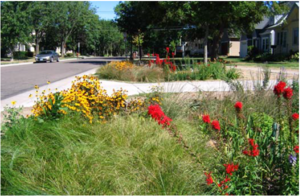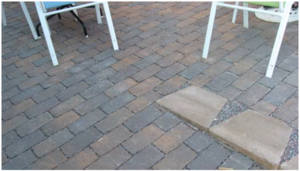
MS4 fact sheet - Retrofitting: Infiltration, Filtration & Bioretention
Retrofitting can be used to achieve highly effective stormwater management that reduces runoff volume, increases ground water recharge, improves surface water quality, provides thermal benefits and helps mimic pre-development hydrology. Retrofits such as rain gardens and swales are versatile because they can be constructed in small areas and easily integrated into existing residential and commercial sites.
This fact sheet provides a list of practices and applications for small-scale sites and includes discussion on the associated benefits and costs.
Contents
Benefits / pollution reduction
Retrofitting is a way to rehabilitate watersheds that have a significant amount of imperviousness and little stormwater treatment. When properly designed, constructed, and maintained, BMP retrofits, as discussed here, increase the aesthetics of an area by providing green space and/or stormwater educational opportunities. Retrofitting has the potential to help achieve nondegradation requirements and Total Maximum Daily Load (TMDL) allocations for impaired waters as well as protect resources that may be experiencing increased pressure from other areas of the watershed. Stormwater retrofits are generally employed to:
- fix past mistakes and maintenance problems;
- solve chronic flooding problems;
- serve as stormwater demonstration and education opportunities;
- trap trash and floatables;
- reduce runoff volumes to combined sewers;
- restore stream corridors;
- reduce specific pollutants;
- reduce downstream channel erosion;
- support stream restoration efforts; and/or
- recharge shallow ground water.
The preceding list was adapted from the manual Urban Stormwater Retrofit Practices created by the Center for Watershed Protection, which has tables listing retrofit objectives and implementation options, including pollutant removal capabilities of retrofit options.
Program development and implementation
Retrofit programs can be effectively implemented on both public and private properties. Municipally driven projects can be used as examples to encourage private landowner participation. Municipal Separate Storm Sewer System (MS4) staff can also encourage landowners to install retrofit practices using a variety of methods such as those identified below. Using a MS4 directed approach along with a program that encourages landowner retrofits will generally realize the greatest benefits.
Retrofit designs
Through appropriate planning and best management practice (BMP) selection, almost any type of BMP can be used in retrofitting existing infrastructure. BMP selection depends on site location and characteristics. The existing land use and site objectives can indicate which BMPs are more likely to be successful in a retrofit situation.
The following list of retrofit BMPs are examples categorized based on the likely application of each. These lists are not meant to exclude BMPs from particular land uses but rather provide a guide to identifying the best BMPs for your MS4. Individual project constraints will dictate which BMP is the most appropriate in a given situation. Descriptions of these practices and design recommendations can be found in the Minnesota Stormwater Manual or the Center for Watershed Protection Manual referenced above.
- Intensive land use retrofit BMPs
- Residential retrofit BMPs
- Pond (new or alteration of existing system)
- French drains
- Rain barrels
- Rain gardens
- Small and large bioretention
- Water quality swale
- Structural sand filter
MS4 directed retrofits
Retrofit projects that are directly implemented or cost-shared by the MS4 usually include larger practices or systematic implementation of smaller retrofits. Public waters, ditches and infrastructure usually provide the greatest opportunities for MS4 directed stormwater BMP retrofits. Care should be taken to locate BMPs where they provide the best water quality benefit.
The City of Burnsville rain gardens are one example of a municipality installing retrofits to protect a waterbody. The city identified 17 locations in a neighborhood and worked with the homeowners to construct, plant, and monitor the rain gardens. This project is a great example of using city and homeowner resources and collaborating with conservation districts to create a great product that reduces downstream runoff volumes and associated phosphorus loading.
Another example is the City of Maplewood. The City constructed their first rain garden in 1996 and has since launched an aggressive installation campaign. Today they have 450 home rain gardens and over 30 rain gardens on public land. Their policies incorporate rain gardens into street reconstructions, residential retrofits and business developments.
On a much larger scale, the City of Seattle, Washington took on 32 acres and 15 residential blocks for the Street Edge Alternatives project (SEA Streets). This project incorporated networks of stormwater BMP features. Surface runoff discharges to vegetated swales, amended soils, and rain gardens. Swales with permeable weirs were used in steeper areas to help control runoff velocity and volumes, while rain gardens were installed in flatter terrain.
Individual landowner directed retrofits
In addition to taking on retrofits directly, MS4s can use stormwater programs that encourage private party retrofits. These programs work by providing financial incentives for homeowners and businesses to make stormwater improvements to their properties.
Grants and cost-share programs: These types of programs are offered by many government agencies to address water quality issues. The specifics of programs vary by grantor but all are based on the idea of providing financial assistance to private parties to incentivize retrofit installations. Generally, this funding will need to be matched and can be used for design, installation and materials to construct water quality features. Many local examples exist in Minnesota; some that may be helpful to review include the following:
- Minnehaha Creek Watershed District Cost-Share Program – This program is available to neighborhood associations, lake and stream associations, schools, cities, businesses and other groups to do projects that have an environmental benefit and an educational component.
- Rice Creek Watershed District Grant Programs – Three different grant programs are available through the RCWD: 1) Grants for up to 50 percent of the project cost are available for residential and municipal projects that improve water quality; 2) The Landscaping for Clean Water rebate program provides funds to individuals that want to plant native grasses; and 3) The Urban Stormwater Remediation cost-share program assists public entities with improving stormwater in redevelopment and infrastructure improvement processes. This program is implemented through conservation districts.
- Any of many local grant opportunities listed on the Blue Thumb: Planting for Clean Water.
Stormwater utility credit programs: These programs involve accounting for stormwater management costs in the same manner that other city services are counted, with a line item on a bill. Funds are generated through per-plot fees based on the amount of runoff leaving each plot that enters the MS4’s stormwater conveyance system. The fee payer is given methods to reduce this fee, such as infiltrating or treating a volume of runoff from their property. This method has been applied locally and throughout the nation; two Minnesota examples follow.
- Minneapolis Stormwater Utility Credit Program – This program provides stormwater credits to people who use onsite tools to improve the quantity and/or quality of runoff leaving their property. The amount of fee reduction can be up to 100 percent for designs certified by a Minnesota registered professional engineer.
- Baxter, MN, Stormwater Utility Credits – The city provides commercial properties the chance to install stormwater BMPs with a maximum possible reduction of 30 percent off the total utility fee bill.
Maintenance considerations
Retrofit BMP maintenance considerations can be substantial, vary considerably based on the type of practice installed, and are paramount to the short and long term success of the BMP function. See fact sheets on Pervious Pavements, Green Roofs and Rainwater Harvesting/ Stormwater Reuse and Rain Barrel Programs for maintenance regarding each of these practices.
Some of the maintenance agreements and activities associated with BMP retrofits are similar to those performed for conventional landscapes and stormwater systems; however, the scale, location, and the nature of a BMP approach will require new maintenance strategies.
Studies have shown that maintenance costs associated with LID are similar to traditional landscapes. Maintenance responsibilities may be taken on by the MS4 whether on MS4 or private property. Legal documentation providing for the latter scenario is recommended to facilitate proper maintenance of the installation in perpetuity. Likewise, retrofit BMP programs should provide a legal document template to be completed and recorded with the city by private landowners in the case where the MS4 will not be conducting maintenance. At a minimum, annual inspections of the BMPs should be conducted, and a plan should be in place for any necessary repairs that are discovered through routine inspections.
Maintenance considerations of a retrofit program, whether it is MS4 or individual directed, vary depending on the intensity of the program implemented; but at a minimum maintenance should include periodic review and revision based on research studies, new technology, and feedback from implementation of past retrofits.
Typical cost
The cost of implementing a retrofit program varies significantly based on the scope of the program. Programs will have costs for administration, marketing and implementation.
Typical costs for BMP retrofits are 1.5 to 4 times higher than the cost of BMPs in new development. This is largely due to site constraints and having a greater number of interested parties involved in the project. The approximate costs for BMPs are reported in the CWP’s manual: Urban Stormwater Retrofit Practice. Each site cost will vary based on complexity and size of the project. Generally speaking, the intensive land use retrofit BMPs require less land but may have higher costs associated with them, whereas the residential retrofit BMPs require more land but can often be installed for a lower cost.
This page was last edited on 23 January 2023, at 22:56.

